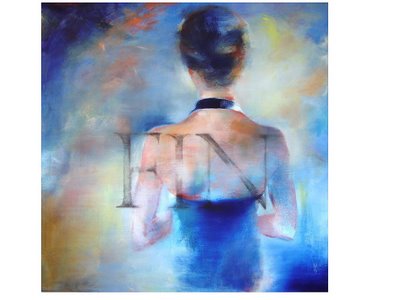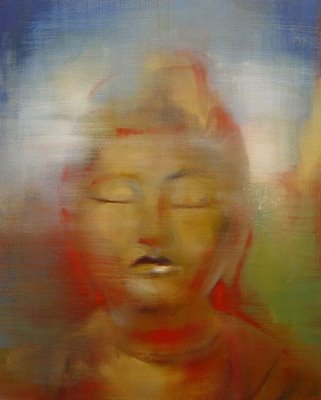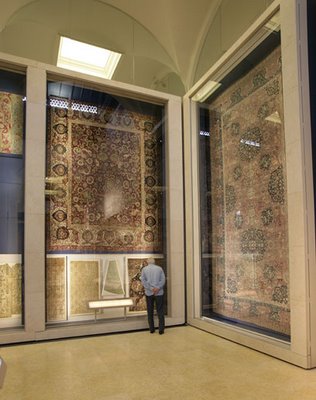
Gregg Chadwick
Screen Memories (Fin de Cinema)
60"x60" oil on linen 2002
A new poem by Kent Chadwick about the experience of leaving a theater after watching a film:
Exiting
the dream, the dark left behind,
done sipping our coke, done suckling on
the Big Nipple of Hollywood, christened
so by Bertolucci at the Oscars,
the credits rolling as the lights come up,
stumbling from our shared, climactic dream,
fantasy experienced in common,
back to the foyer of reality,
the cacophony of unscripted sound,
shock of daylight after the matinee,
the third act’s satisfaction rippling
within us, but lessening so quickly
that we try to prolong it conversing:
What have we learned? What truth? What lies?
We learn lies too: pseudo-ideas
that bond with what we think we know
but catalyze wrong conclusions.
The lies in question here are facts
refined beyond reality,
simplified so as to produce
more powerful pure emotion
(while complexity fosters
more nuanced and reflective thought).
The troika of Hollywood lies:
First—that violence is redemptive—
that just enough judicious force
can reform the schoolyard bully,
clean up Dodge City, save the Bronx.
Second—that love is just romance—
that the romantic spark is love’s
one true and only kindling,
that sex is its one fulfillment
and passion its signature sign.
Third—that the hero always wins
and gets just what he wants—
that happy endings are the rule,
that every problem can be solved
and in time for the curtain call.
We leave accepting the unreal,
not doubting the impossible,
more prone to choose expedience,
less willing to show forbearance,
primed to demand happiness now.
Yet poetry, like movies, lies.
For that Plato and Mohammed
elected to banish this art.
There are lies we choose to live by—
fiction is our euphemism,
poetry their celebration—
humor, hope, imagination,
artifices over the void
contra despair, versus ennui.
The lies of classic tragedy
to those of sentimental soaps
and Hollywood’s cheap romances
fulfill a basic human need:
Aristotle’s art catharsis.
Two types of lies to consider:
imagined facts
subverted facts.
The arts create much neater worlds,
places our minds can understand,
invent untruths, imagine facts,
things that never have been nor will.
But the artist and audience
agree they’re false. The artist does
not conceal her art nor does she
attempt to delude the viewer.
Instead we play an elaborate
game where the artist tries to win
a suspension of disbelief,
a surrender of our careful
guard against both lies and liars
with bold strokes and rich verities.
And the frisson of art is when
the artist-magician defeats
our disbelief and seduces
us into a private world where
magic happens regularly.
These imagined facts are tall tale
bones for our imagination
to gnaw on down to the marrow.
Not so lies of subverted facts.
These violate reality
to make things easy, to make things
fit within the artificial
system of a Pollyanna,
huckster, conman, true believer,
propagandist, or demagogue.
The worst subverted fact is “they”—
smooth, simple, and innocuous,
insidious as a virus.
“They:” the demonized other crowned
responsible for all our ills.
“They” fills our rhetoric, our news,
our elections, and our movies.
Ungrammatical Pogo hints
at the antidote: We have met
the enemy, and they is us.
Though, like cartoons, films teach truths too.
What have we learned? Signs and wonders
abound: we have new eyes and ears;
we have slipped inside another,
seen from a different angle
how the world alternately feels,
practiced cheering for a stranger.
Scenes have been framed and staged for us
of incomparable beauty
that thrill our sense of life’s glory.
We have been given life lessons
in how to kiss and how to fight,
how to suffer and how to dance,
how to laugh at our foolishness.
Again we’ve been reminded how
easily we break into song.
The theme song returns to mind and we want
to hum and hold onto its bright tune as
the double doors push us back outside changed
from audience to individuals,
our feelings pitched, ideas stirred, images
swirling then forming into memory
and new stories settling in our souls.

 R.B. Kitaj Lectures at Hammer Museum
R.B. Kitaj Lectures at Hammer Museum















































